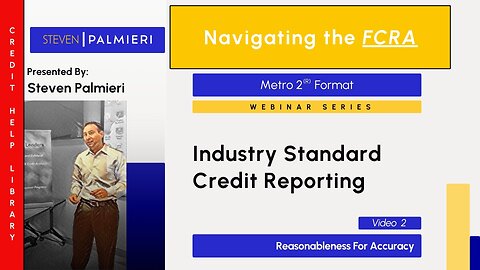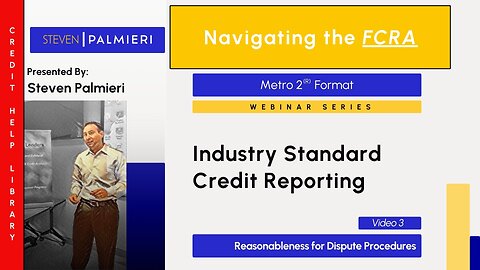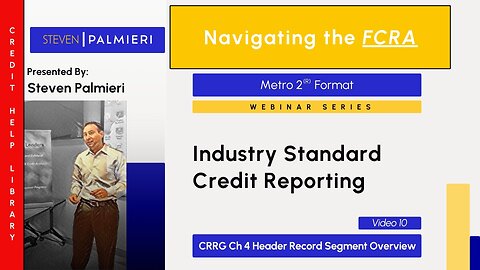
Credit Help: FCRA - Metro 2 Format Industry Standard Credit Reporting
73 videos
Updated 8 months ago
This webinar series will break down how the credit reporting industry standard "Metro 2" works and how you can use it to audit credit reports for errors based on the FCRA's "maximum possible accuracy" standard.
-
What is an Industry Standard
 Steven PalmieriThe video explains how to use Metro 2, the credit reporting industry's standard, to read credit reports, identify errors, and draft dispute letters to consumer reporting agencies. Metro 2, established by the Consumer Data Industry Association (formerly the Credit Bureaus Trade Association), is a technical standard adopted across the credit reporting industry. It is detailed in the annually updated Credit Reporting Resource Guide. The video highlights that under the Fair Credit Reporting Act (FCRA), credit bureaus and furnishers must adhere to a "reasonableness" standard to ensure reported data is as accurate as possible. By understanding Metro 2, individuals can leverage this standard to evaluate the accuracy of credit report information and challenge discrepancies effectively.9 views
Steven PalmieriThe video explains how to use Metro 2, the credit reporting industry's standard, to read credit reports, identify errors, and draft dispute letters to consumer reporting agencies. Metro 2, established by the Consumer Data Industry Association (formerly the Credit Bureaus Trade Association), is a technical standard adopted across the credit reporting industry. It is detailed in the annually updated Credit Reporting Resource Guide. The video highlights that under the Fair Credit Reporting Act (FCRA), credit bureaus and furnishers must adhere to a "reasonableness" standard to ensure reported data is as accurate as possible. By understanding Metro 2, individuals can leverage this standard to evaluate the accuracy of credit report information and challenge discrepancies effectively.9 views -
Reasonableness for Accuracy
 Steven PalmieriThe video explains the importance of the Metro 2 industry standard in the context of the Fair Credit Reporting Act (FCRA) and its role in ensuring accurate credit reporting. The FCRA is a reasonable procedures statute that requires credit bureaus, furnishers, and related parties to employ reasonable measures to ensure the accuracy of consumer reports. Specifically, FCRA Section 1681e mandates that consumer reporting agencies (CRAs) must follow reasonable procedures to achieve "maximum possible accuracy" in the information they report about individuals. However, the term "accuracy" is not explicitly defined in the FCRA, leaving its interpretation to plain English, case law, and industry standards. This is where Metro 2 becomes critical. Metro 2 is an industry-standard format developed and adopted by the credit bureaus themselves to meet the FCRA's accuracy requirements. It provides a clear, authoritative framework for reporting credit data, allowing users to understand how information is structured in a credit report. For someone aiming to read a credit report accurately, identify errors, and draft dispute letters to CRAs, Metro 2 serves as a reliable tool. By aligning with this standard, individuals can assess whether the data in their report meets the "maximum possible accuracy" threshold and use it as a basis to challenge inaccuracies effectively.3 views
Steven PalmieriThe video explains the importance of the Metro 2 industry standard in the context of the Fair Credit Reporting Act (FCRA) and its role in ensuring accurate credit reporting. The FCRA is a reasonable procedures statute that requires credit bureaus, furnishers, and related parties to employ reasonable measures to ensure the accuracy of consumer reports. Specifically, FCRA Section 1681e mandates that consumer reporting agencies (CRAs) must follow reasonable procedures to achieve "maximum possible accuracy" in the information they report about individuals. However, the term "accuracy" is not explicitly defined in the FCRA, leaving its interpretation to plain English, case law, and industry standards. This is where Metro 2 becomes critical. Metro 2 is an industry-standard format developed and adopted by the credit bureaus themselves to meet the FCRA's accuracy requirements. It provides a clear, authoritative framework for reporting credit data, allowing users to understand how information is structured in a credit report. For someone aiming to read a credit report accurately, identify errors, and draft dispute letters to CRAs, Metro 2 serves as a reliable tool. By aligning with this standard, individuals can assess whether the data in their report meets the "maximum possible accuracy" threshold and use it as a basis to challenge inaccuracies effectively.3 views -
Reasonableness for Dispute Procedures
 Steven PalmieriThe video highlights how the Metro 2 industry standard aids in disputing inaccuracies on credit reports under the Fair Credit Reporting Act (FCRA), focusing on the "reasonableness" requirement for dispute procedures. The FCRA mandates that consumer reporting agencies (CRAs) not only maintain reasonable procedures for maximum possible accuracy (as seen in prior discussions) but also conduct reasonable reinvestigations when consumers dispute information. This is outlined in FCRA Section 1681i, the most commonly used dispute pathway, which requires CRAs to reasonably reinvestigate reported errors. The term "reasonable" appears four times in this section, emphasizing its importance. Metro 2, as an industry standard created and adopted by the credit bureaus, provides a concrete framework for assessing accuracy and identifying errors in credit reports. When disputing inaccuracies, understanding Metro 2 allows consumers to pinpoint deviations from this standard and clearly notify CRAs of specific errors. The video advises against vague disputes or legal accusations (unless one is legally qualified) and instead recommends using Metro 2 to highlight discrepancies. If the CRA fails to correct or delete the erroneous data after being notified, it becomes easier to argue that their reinvestigation procedures were not reasonable, strengthening a case for noncompliance. This approach simplifies the process of reading credit reports, finding errors, and drafting effective dispute letters to CRAs.9 views
Steven PalmieriThe video highlights how the Metro 2 industry standard aids in disputing inaccuracies on credit reports under the Fair Credit Reporting Act (FCRA), focusing on the "reasonableness" requirement for dispute procedures. The FCRA mandates that consumer reporting agencies (CRAs) not only maintain reasonable procedures for maximum possible accuracy (as seen in prior discussions) but also conduct reasonable reinvestigations when consumers dispute information. This is outlined in FCRA Section 1681i, the most commonly used dispute pathway, which requires CRAs to reasonably reinvestigate reported errors. The term "reasonable" appears four times in this section, emphasizing its importance. Metro 2, as an industry standard created and adopted by the credit bureaus, provides a concrete framework for assessing accuracy and identifying errors in credit reports. When disputing inaccuracies, understanding Metro 2 allows consumers to pinpoint deviations from this standard and clearly notify CRAs of specific errors. The video advises against vague disputes or legal accusations (unless one is legally qualified) and instead recommends using Metro 2 to highlight discrepancies. If the CRA fails to correct or delete the erroneous data after being notified, it becomes easier to argue that their reinvestigation procedures were not reasonable, strengthening a case for noncompliance. This approach simplifies the process of reading credit reports, finding errors, and drafting effective dispute letters to CRAs.9 views -
Metro 2 Table of Contents
 Steven PalmieriThe video introduces the Metro 2 industry standard, as outlined in the 2020 Credit Reporting Resource Guide (CRRG) published by the Consumer Data Industry Association (CDIA), and explains its structure to help viewers use it for accurately reading credit reports, identifying errors, and crafting dispute letters to consumer reporting agencies (CRAs). Metro 2 is critical because it aligns with the FCRA’s requirement for reasonable procedures to ensure maximum possible accuracy, providing a standardized format that credit bureaus and furnishers follow. The CRRG’s table of contents breaks down Metro 2 into key sections. Chapter 1 outlines the roles of involved parties (e.g., CDIA, credit bureaus, furnishers, regulators like the CFPB and FTC). Chapter 2 explains the importance of Metro 2 as an industry standard for automated data reporting. Chapter 3 details the Metro 2 format, organizing data into segments like a book with chapters: the base segment (primary consumer data), J1/J2 segments (associated consumers), K1-K4 segments (creditor and payment details), L1 (account changes), N1 (employment), and header/trailer records (file transfer data). Chapter 4 provides field definitions, listing how each segment’s data fields should be reported, which is essential for spotting inconsistencies across reports from different bureaus. Chapter 5 offers exhibits with valid data options, Chapter 6 addresses FAQs (e.g., reporting repossessions or charge-offs), and Chapter 7 is a glossary. Chapters 8-13 cover implementation checklists and specific guidelines (e.g., child support, student loans, mortgages), while Chapter 14 details the E-OSCAR dispute system. For readers, Metro 2’s structure—especially Chapters 3 and 4—enables a precise analysis of credit report data against the standard. By comparing reported fields (e.g., payment history, creditor info) to Metro 2 specifications, users can identify errors and reference these discrepancies in dispute letters, leveraging the bureaus’ own standard to demand corrections. The FAQ and examples in later chapters further clarify complex scenarios, enhancing dispute effectiveness.4 views
Steven PalmieriThe video introduces the Metro 2 industry standard, as outlined in the 2020 Credit Reporting Resource Guide (CRRG) published by the Consumer Data Industry Association (CDIA), and explains its structure to help viewers use it for accurately reading credit reports, identifying errors, and crafting dispute letters to consumer reporting agencies (CRAs). Metro 2 is critical because it aligns with the FCRA’s requirement for reasonable procedures to ensure maximum possible accuracy, providing a standardized format that credit bureaus and furnishers follow. The CRRG’s table of contents breaks down Metro 2 into key sections. Chapter 1 outlines the roles of involved parties (e.g., CDIA, credit bureaus, furnishers, regulators like the CFPB and FTC). Chapter 2 explains the importance of Metro 2 as an industry standard for automated data reporting. Chapter 3 details the Metro 2 format, organizing data into segments like a book with chapters: the base segment (primary consumer data), J1/J2 segments (associated consumers), K1-K4 segments (creditor and payment details), L1 (account changes), N1 (employment), and header/trailer records (file transfer data). Chapter 4 provides field definitions, listing how each segment’s data fields should be reported, which is essential for spotting inconsistencies across reports from different bureaus. Chapter 5 offers exhibits with valid data options, Chapter 6 addresses FAQs (e.g., reporting repossessions or charge-offs), and Chapter 7 is a glossary. Chapters 8-13 cover implementation checklists and specific guidelines (e.g., child support, student loans, mortgages), while Chapter 14 details the E-OSCAR dispute system. For readers, Metro 2’s structure—especially Chapters 3 and 4—enables a precise analysis of credit report data against the standard. By comparing reported fields (e.g., payment history, creditor info) to Metro 2 specifications, users can identify errors and reference these discrepancies in dispute letters, leveraging the bureaus’ own standard to demand corrections. The FAQ and examples in later chapters further clarify complex scenarios, enhancing dispute effectiveness.4 views -
Ch 1 Overview
 Steven PalmieriThe video summarizes Chapter 1 of the Metro 2 Credit Reporting Resource Guide, focusing on the roles and responsibilities of parties involved in the Metro 2 format, which is key for readers aiming to accurately read credit reports, identify errors, and draft dispute letters to consumer reporting agencies (CRAs). This brief chapter emphasizes that credit information is sensitive, requiring accuracy, completeness, and fairness to consumers. These responsibilities extend beyond CRAs to include furnishers (e.g., credit grantors like Capital One or Midland Credit Management). Key players outlined include the Consumer Data Industry Association (CDIA, the credit bureaus’ trade group), CRAs, the Metro 2 Format Task Force, the E-OSCAR support team, data furnishers, and regulators like the CFPB and FTC. Understanding these roles helps readers grasp who is accountable for maintaining Metro 2 compliance, enabling them to pinpoint inaccuracies in credit reports and reference these responsibilities in disputes with CRAs.3 views
Steven PalmieriThe video summarizes Chapter 1 of the Metro 2 Credit Reporting Resource Guide, focusing on the roles and responsibilities of parties involved in the Metro 2 format, which is key for readers aiming to accurately read credit reports, identify errors, and draft dispute letters to consumer reporting agencies (CRAs). This brief chapter emphasizes that credit information is sensitive, requiring accuracy, completeness, and fairness to consumers. These responsibilities extend beyond CRAs to include furnishers (e.g., credit grantors like Capital One or Midland Credit Management). Key players outlined include the Consumer Data Industry Association (CDIA, the credit bureaus’ trade group), CRAs, the Metro 2 Format Task Force, the E-OSCAR support team, data furnishers, and regulators like the CFPB and FTC. Understanding these roles helps readers grasp who is accountable for maintaining Metro 2 compliance, enabling them to pinpoint inaccuracies in credit reports and reference these responsibilities in disputes with CRAs.3 views -
Ch 2 Overview
 Steven PalmieriThe video summarizes Chapter 2 of the Metro 2 Credit Reporting Resource Guide, explaining how Metro 2 serves as a critical link between the Fair Credit Reporting Act’s (FCRA) "reasonable procedures" requirement and the goal of "maximum possible accuracy" in credit reporting. This chapter, titled "Automated Data Reporting," highlights Metro 2 as an industry standard accepted by all consumer reporting agencies (CRAs) and compliant with all applicable federal and state laws, not just the FCRA. It ensures data integrity and consistency, mandating that furnishers report all accounts at least monthly—a key point for readers to note when spotting errors, as non-monthly reporting violates Metro 2’s own guidelines under the "Industry Reporting Standards" section. Chapter 2 also includes quick reference guides with charts tailored to specific credit types, such as banking, installment loans, child support, credit cards, debt buyers, mortgages, student loans (federal and private), and utility accounts. These guides help standardize reporting across industries. For readers aiming to read credit reports accurately, identify errors, and draft dispute letters to CRAs, Chapter 2 provides a foundation: they can use Metro 2’s monthly reporting requirement and consistency standards to challenge incomplete or inconsistent data, citing the industry’s own rules as evidence of inaccuracies.9 views
Steven PalmieriThe video summarizes Chapter 2 of the Metro 2 Credit Reporting Resource Guide, explaining how Metro 2 serves as a critical link between the Fair Credit Reporting Act’s (FCRA) "reasonable procedures" requirement and the goal of "maximum possible accuracy" in credit reporting. This chapter, titled "Automated Data Reporting," highlights Metro 2 as an industry standard accepted by all consumer reporting agencies (CRAs) and compliant with all applicable federal and state laws, not just the FCRA. It ensures data integrity and consistency, mandating that furnishers report all accounts at least monthly—a key point for readers to note when spotting errors, as non-monthly reporting violates Metro 2’s own guidelines under the "Industry Reporting Standards" section. Chapter 2 also includes quick reference guides with charts tailored to specific credit types, such as banking, installment loans, child support, credit cards, debt buyers, mortgages, student loans (federal and private), and utility accounts. These guides help standardize reporting across industries. For readers aiming to read credit reports accurately, identify errors, and draft dispute letters to CRAs, Chapter 2 provides a foundation: they can use Metro 2’s monthly reporting requirement and consistency standards to challenge incomplete or inconsistent data, citing the industry’s own rules as evidence of inaccuracies.9 views -
Ch 3 Overview
 Steven PalmieriThe video provides an overview of Chapter 3 of the Metro 2 Credit Reporting Resource Guide, detailing the Metro 2 format as a data standard and its practical use for readers aiming to accurately read credit reports, identify errors, and draft dispute letters to consumer reporting agencies (CRAs). Chapter 3 is divided into four sections: business requirements, Metro 2 training, programming standards, and production tips, with a focus on how furnishers (e.g., Capital One) report data to CRAs. The "Business Requirements" section explains why Metro 2 is beneficial for furnishers, beyond being an industry standard mandated by credit bureaus. It ties Metro 2 to the FCRA’s "maximum possible accuracy" requirement, stating that it provides a single, standardized computer layout for reporting accurate, complete, and timely data monthly. This consistency should ensure identical data across all bureaus (Equifax, Experian, TransUnion), making discrepancies between reports a clear basis for disputes. Metro 2 supports compliance with federal and state laws, covering account-level (e.g., payment status) and consumer-level (e.g., name, address) data, including fields like date of first delinquency, account type, and co-borrower details (J1/J2 segments). The "Programming Standards" section notes two data transfer formats—character and packed—emphasizing that deviations compromise data integrity, a point readers can use to challenge inaccurate reporting. "Production Tips" guide furnishers on entering data for maximum accuracy, while "Record Layouts" outline data segments (e.g., base segment for primary borrower, K1 for original creditor, J1/J2 for co-borrowers) and specify required fields. Charts in this section list data fields, indicating whether they are mandatory or applicable, helping readers identify incomplete reporting (e.g., missing monthly updates for required fields like payment history). For readers, Chapter 3 equips them to compare credit report data against Metro 2’s format. By cross-referencing report fields with the chapter’s charts, they can spot missing or inconsistent data—such as unreported required fields or discrepancies across bureaus—and use these findings to craft dispute letters, citing Metro 2 as evidence of noncompliance with the industry standard.11 views 1 comment
Steven PalmieriThe video provides an overview of Chapter 3 of the Metro 2 Credit Reporting Resource Guide, detailing the Metro 2 format as a data standard and its practical use for readers aiming to accurately read credit reports, identify errors, and draft dispute letters to consumer reporting agencies (CRAs). Chapter 3 is divided into four sections: business requirements, Metro 2 training, programming standards, and production tips, with a focus on how furnishers (e.g., Capital One) report data to CRAs. The "Business Requirements" section explains why Metro 2 is beneficial for furnishers, beyond being an industry standard mandated by credit bureaus. It ties Metro 2 to the FCRA’s "maximum possible accuracy" requirement, stating that it provides a single, standardized computer layout for reporting accurate, complete, and timely data monthly. This consistency should ensure identical data across all bureaus (Equifax, Experian, TransUnion), making discrepancies between reports a clear basis for disputes. Metro 2 supports compliance with federal and state laws, covering account-level (e.g., payment status) and consumer-level (e.g., name, address) data, including fields like date of first delinquency, account type, and co-borrower details (J1/J2 segments). The "Programming Standards" section notes two data transfer formats—character and packed—emphasizing that deviations compromise data integrity, a point readers can use to challenge inaccurate reporting. "Production Tips" guide furnishers on entering data for maximum accuracy, while "Record Layouts" outline data segments (e.g., base segment for primary borrower, K1 for original creditor, J1/J2 for co-borrowers) and specify required fields. Charts in this section list data fields, indicating whether they are mandatory or applicable, helping readers identify incomplete reporting (e.g., missing monthly updates for required fields like payment history). For readers, Chapter 3 equips them to compare credit report data against Metro 2’s format. By cross-referencing report fields with the chapter’s charts, they can spot missing or inconsistent data—such as unreported required fields or discrepancies across bureaus—and use these findings to craft dispute letters, citing Metro 2 as evidence of noncompliance with the industry standard.11 views 1 comment -
Ch 4 Overview
 Steven PalmieriThe video summarizes Chapter 4 of the Metro 2 Credit Reporting Resource Guide, focusing on its role in defining data fields, which is essential for readers aiming to accurately read credit reports, identify errors, and draft dispute letters to consumer reporting agencies (CRAs). While Chapters 2 and 3 connect Metro 2 to the FCRA’s "maximum possible accuracy" requirement, Chapter 4 provides the practical tools: detailed definitions of data fields organized by segment. These segments, likened to chapters in a book, include the header record (basic file info), base segment (consumer account details like status, balance, past due amount), J1 segment (co-borrower at the same address), J2 segment (co-borrower at a different address), K1 (original creditor), K2 (purchased account info), K3 (mortgage data), K4 (specialized payment info, e.g., balloon payments), L1 (account number changes), N1 (employment), and trailer record (batch verification). Each segment lists specific fields—like names, dates, or balances—and how they should be reported per Metro 2 standards. For readers, this chapter is key to decoding a credit report: by mapping reported data to Metro 2’s required fields, they can verify accuracy and completeness. Discrepancies, such as missing fields or inconsistent co-borrower data (noting Metro 2 allows multiple J1/J2 entries), become clear errors to dispute. Chapter 4 thus empowers users to cross-reference a report against the industry standard, pinpoint factual inaccuracies, and build evidence-based dispute letters citing Metro 2 noncompliance.5 views
Steven PalmieriThe video summarizes Chapter 4 of the Metro 2 Credit Reporting Resource Guide, focusing on its role in defining data fields, which is essential for readers aiming to accurately read credit reports, identify errors, and draft dispute letters to consumer reporting agencies (CRAs). While Chapters 2 and 3 connect Metro 2 to the FCRA’s "maximum possible accuracy" requirement, Chapter 4 provides the practical tools: detailed definitions of data fields organized by segment. These segments, likened to chapters in a book, include the header record (basic file info), base segment (consumer account details like status, balance, past due amount), J1 segment (co-borrower at the same address), J2 segment (co-borrower at a different address), K1 (original creditor), K2 (purchased account info), K3 (mortgage data), K4 (specialized payment info, e.g., balloon payments), L1 (account number changes), N1 (employment), and trailer record (batch verification). Each segment lists specific fields—like names, dates, or balances—and how they should be reported per Metro 2 standards. For readers, this chapter is key to decoding a credit report: by mapping reported data to Metro 2’s required fields, they can verify accuracy and completeness. Discrepancies, such as missing fields or inconsistent co-borrower data (noting Metro 2 allows multiple J1/J2 entries), become clear errors to dispute. Chapter 4 thus empowers users to cross-reference a report against the industry standard, pinpoint factual inaccuracies, and build evidence-based dispute letters citing Metro 2 noncompliance.5 views -
Ch 4 Segment Overview
 Steven PalmieriThe video provides an overview of Chapter 4 of the Metro 2 Credit Reporting Resource Guide, focusing on its detailed listing of data fields, their names, and definitions—crucial for readers aiming to accurately read credit reports, identify errors, and draft dispute letters to consumer reporting agencies (CRAs). Titled "Field Definitions," Chapter 4 is lengthy yet straightforward, serving as a reference to understand how data originates and the rules for its reporting, enabling users to judge accuracy against the Metro 2 standard. It organizes fields by segments, likened to chapters in a book, starting with the header record (e.g., Field #0: "block descriptor word") and continuing through segments like base, J1, J2, and trailer, as introduced earlier. Each segment’s chart includes a field number, name, and description, with additional columns on character vs. packed format (data transmission details) that readers can initially ignore, as they don’t impact accuracy assessment. For users, Chapter 4 is a practical tool: by referencing these definitions, they can map credit report data to Metro 2 requirements, spotting errors like missing or misreported fields. This clarity strengthens dispute letters by grounding claims in the industry standard’s own rules.7 views
Steven PalmieriThe video provides an overview of Chapter 4 of the Metro 2 Credit Reporting Resource Guide, focusing on its detailed listing of data fields, their names, and definitions—crucial for readers aiming to accurately read credit reports, identify errors, and draft dispute letters to consumer reporting agencies (CRAs). Titled "Field Definitions," Chapter 4 is lengthy yet straightforward, serving as a reference to understand how data originates and the rules for its reporting, enabling users to judge accuracy against the Metro 2 standard. It organizes fields by segments, likened to chapters in a book, starting with the header record (e.g., Field #0: "block descriptor word") and continuing through segments like base, J1, J2, and trailer, as introduced earlier. Each segment’s chart includes a field number, name, and description, with additional columns on character vs. packed format (data transmission details) that readers can initially ignore, as they don’t impact accuracy assessment. For users, Chapter 4 is a practical tool: by referencing these definitions, they can map credit report data to Metro 2 requirements, spotting errors like missing or misreported fields. This clarity strengthens dispute letters by grounding claims in the industry standard’s own rules.7 views -
Ch 4 Header Record Segment Overview
 Steven PalmieriThe video provides an overview of the Header Record segment from Chapter 4 of the Metro 2 Credit Reporting Resource Guide, tailored for readers aiming to use the Metro 2 standard to accurately read credit reports, find errors, and send dispute letters to consumer reporting agencies (CRAs). The Header Record includes data fields that are generally not visible on a consumer credit report, as they are designed for internal data transfer between furnishers (e.g., creditors) and credit bureaus, helping their systems categorize and store the information. One notable exception is Field #8, the "Activity Date," which reflects the most recent account update and corresponds to the "date of last activity" on a report. This field can be useful for verifying timely updates per Metro 2’s standards, potentially revealing errors like stale or missing dates for disputes. However, the other fields in this segment are rarely relevant for daily consumer audits or dispute purposes, limiting their practical use for readers.11 views
Steven PalmieriThe video provides an overview of the Header Record segment from Chapter 4 of the Metro 2 Credit Reporting Resource Guide, tailored for readers aiming to use the Metro 2 standard to accurately read credit reports, find errors, and send dispute letters to consumer reporting agencies (CRAs). The Header Record includes data fields that are generally not visible on a consumer credit report, as they are designed for internal data transfer between furnishers (e.g., creditors) and credit bureaus, helping their systems categorize and store the information. One notable exception is Field #8, the "Activity Date," which reflects the most recent account update and corresponds to the "date of last activity" on a report. This field can be useful for verifying timely updates per Metro 2’s standards, potentially revealing errors like stale or missing dates for disputes. However, the other fields in this segment are rarely relevant for daily consumer audits or dispute purposes, limiting their practical use for readers.11 views








